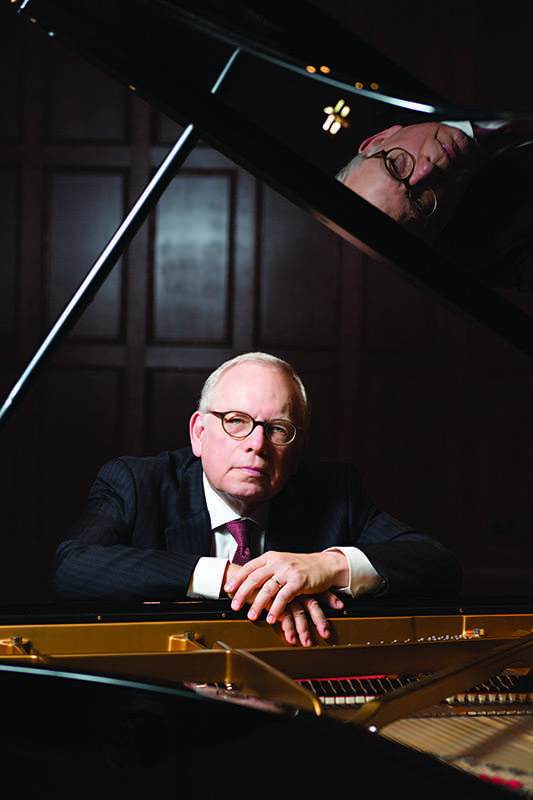Takács’ Reading of Beethoven a Triumph
Professor of Piano Peter Takács poses at the piano. The audience received his Beethoven repertoire enthusiatically at a faculty recital Sunday at Warner Concert Hall.
November 13, 2015
Some people are born to do something specific. Some might claim that Arthur Rubinstein was born to play Frédéric Chopin, or that Leonard Bernstein was born to conduct Gustav Mahler. It is an incredible experience to listen to artists who have developed such a deep relationship with a particular composer. An instance of this occurred on Sunday night in Warner Concert Hall, when the audience had the honor of hearing Ludwig van Beethoven’s 17th and 21st piano sonatas and Andante in F major (“Andante favori”) performed by Professor of Piano Peter Takács, a man who was born to play Beethoven.
A native of Romania, Takács is a critically acclaimed pianist who has been performing publicly since the age of seven. He entered the Conservatoire National de Paris when he was 14 and eventually went on to study with the legendary pianist Leon Fleisher. Recently, he has dedicated much of his time to studying the music of Beethoven and has released an album, Peter Takács: The Complete Beethoven Piano Sonatas. Complete is certainly an apt description, as this collection boasts not only all 32 public sonatas but other unpublished ones as well. Takács also currently features in three concerts — two of which have passed — at Carnegie Hall this season, which showcase his Beethoven prowess.
The Beethoven Sonatas are pillars of the piano repertoire, often referred to as The New Testament in comparison with Bach’s The Well-Tempered Clavier as The Old Testament. Really, they are an entire literature unto themselves, and Takács chose two of the most popular and important sonatas, Sonata No. 17 in D minor, Op. 31 and Sonata No. 21 in C major, Op. 53, for this concert. Both are from Beethoven’s middle or “Heroic” period. Posterity has bestowed the nickname “Tempest” on the 17th, but the composer never actually referred to it as such. It is a key work in Beethoven’s output; the sonata reveals his break from the style of Mozart and Haydn, particularly through its use of motivic themes rather than a clear-cut melody. The 21st was dedicated to Beethoven’s patron, Count Waldstein, and has been known as “Waldstein” ever since. This titan of a sonata is a landmark in keyboard virtuosity, particularly in the final movement, and even some professional pianists cower before its imposing difficulty.
As Takács took his seat at the piano bench, he collected his thoughts, as if channeling Beethoven, and began to play “The Tempest.” The very first measures allow the performer much interpretive freedom, which leaves room for error. However, Takács’ phrasing, tempo and touch were exquisite. One could tell from the very first chord that a true master was performing. His interpretation was captivating, his dramatic phrasing divine. As the music flowed from stormy to pastoral, Takács’ playing changed from passionate to serene. His delicate, meandering phrases ended with question marks, and the more intense sections were full of unshakeable conviction. As the third movement Perpetuum Mobile began, one could almost hear gusts of swelling wind sweep across the keys. Takács’ choice of tempo was perfect, and it was difficult to ignore the gorgeous sounds emanating from the piano’s hammers.
Between the two sonatas, Takács performed Beethoven’s “Andante favori.” This piece was actually intended to be the second movement of the “Waldstein” sonata but was later replaced. While Takács intended to play the Andante and the “Waldstein” without interruption, the audience briefly applauded after the first movement of the sonata. The pianist seemed flattered, if a bit exasperated, at the outburst. Admittedly, his performance was so riveting that the audience’s reaction was unsurprising. The “Waldstein” sonata is made up of three movements. The first and last are each about 10 minutes long, and the much shorter second movement serves as an introduction to the third. The final movement contains extraordinarily difficult passagework, especially in the first section of the rondo and the coda. Not only did Takács reinforce his reputation for technical brilliance, but his interpretation defined heroism and elegance in Beethoven. When he finished, attendees appeared astonished, and for good reason: His playing perfectly expressed the essence of Beethoven’s pieces.

























